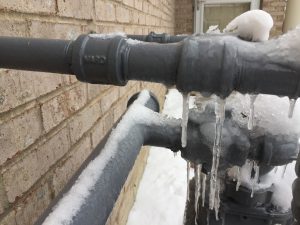Crucial Advice for Preventing Frozen Plumbing in Cold Weather Conditions
Crucial Advice for Preventing Frozen Plumbing in Cold Weather Conditions
Blog Article
The publisher is making a few great points on How to Prevent Your Pipes From Freezing as a whole in this great article further down.

Winter can ruin your plumbing, particularly by freezing pipes. Right here's just how to stop it from happening and what to do if it does.
Introduction
As temperatures drop, the danger of frozen pipes increases, potentially resulting in costly repair work and water damage. Understanding just how to stop icy pipes is essential for property owners in cold environments.
Prevention Tips
Insulating at risk pipelines
Wrap pipelines in insulation sleeves or use warmth tape to safeguard them from freezing temperature levels. Focus on pipes in unheated or external areas of the home.
Heating strategies
Keep interior areas properly heated, especially locations with pipes. Open up closet doors to permit warm air to flow around pipelines under sinks.
Just how to determine icy pipes
Search for lowered water flow from taps, unusual odors or sounds from pipelines, and visible frost on subjected pipelines.
Long-Term Solutions
Architectural changes
Take into consideration rerouting pipelines far from exterior walls or unheated areas. Include added insulation to attics, basements, and crawl spaces.
Updating insulation
Buy high-grade insulation for pipelines, attics, and wall surfaces. Appropriate insulation helps keep constant temperatures and lowers the danger of frozen pipelines.
Protecting Exterior Plumbing
Yard hoses and outside faucets
Detach and drain pipes garden pipes before winter months. Install frost-proof spigots or cover exterior faucets with protected caps.
Recognizing Icy Pipes
What triggers pipelines to ice up?
Pipes freeze when subjected to temperature levels listed below 32 ° F (0 ° C) for expanded durations. As water inside the pipelines ices up, it increases, taxing the pipeline wall surfaces and possibly creating them to rupture.
Dangers and problems
Frozen pipes can cause supply of water interruptions, residential property damages, and expensive repair services. Ruptured pipelines can flooding homes and create extensive structural damage.
Indicators of Frozen Water Lines
Determining icy pipelines early can prevent them from breaking.
What to Do If Your Pipes Freeze
Immediate activities to take
If you think icy pipes, maintain faucets open up to eliminate pressure as the ice melts. Make use of a hairdryer or towels soaked in warm water to thaw pipelines slowly.
Final thought
Preventing frozen pipelines calls for proactive procedures and fast responses. By comprehending the reasons, indicators, and preventive measures, property owners can secure their pipes throughout winter.
5 Ways to Prevent Frozen Pipes
Drain Outdoor Faucets and Disconnect Hoses
First, close the shut-off valve that controls the flow of water in the pipe to your outdoor faucet. Then, head outside to disconnect and drain your hose and open the outdoor faucet to allow the water to completely drain out of the line. Turn off the faucet when done. Finally, head back to the shut-off valve and drain the remaining water inside the pipe into a bucket or container. Additionally, if you have a home irrigation system, you should consider hiring an expert to clear the system of water each year.
Insulate Pipes
One of the best and most cost-effective methods for preventing frozen water pipes is to wrap your pipes with insulation. This is especially important for areas in your home that aren’t exposed to heat, such as an attic. We suggest using foam sleeves, which can typically be found at your local hardware store.
Keep Heat Running at 65
Your pipes are located inside your walls, and the temperature there is much colder than the rest of the house. To prevent your pipes from freezing, The Insurance Information Institute suggests that you keep your home heated to at least 65 degrees, even when traveling. You may want to invest in smart devices that can keep an eye on the temperature in your home while you’re away.
Leave Water Dripping
Moving water — even a small trickle — can prevent ice from forming inside your pipes. When freezing temps are imminent, start a drip of water from all faucets that serve exposed pipes. Leaving a few faucets running will also help relieve pressure inside the pipes and help prevent a rupture if the water inside freezes.
Open Cupboard Doors
Warm your kitchen and bathroom pipes by opening cupboards and vanities. You should also leave your interior doors ajar to help warm air circulate evenly throughout your home.

I have been very drawn to Winter Plumbing Precautions: Preventing Frozen Pipes and I am hoping you enjoyed our entry. Kindly set aside a second to share this blog entry if you liked it. Thanks for your time. Don't forget to visit our blog back soon.
Book Now Report this page